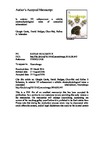Is anterior N2 enhancement a reliable electrophysiological index of concealed information?
| dc.contributor.author | Ganis, Giorgio | |
| dc.contributor.author | Bridges, D | |
| dc.contributor.author | Hsu, C-W | |
| dc.contributor.author | Schendan, Haline | |
| dc.date.accessioned | 2016-09-18T08:36:53Z | |
| dc.date.available | 2016-09-18T08:36:53Z | |
| dc.date.issued | 2016-12 | |
| dc.identifier.issn | 1053-8119 | |
| dc.identifier.issn | 1095-9572 | |
| dc.identifier.uri | http://hdl.handle.net/10026.1/5459 | |
| dc.description | publisher: Elsevier articletitle: Is anterior N2 enhancement a reliable electrophysiological index of concealed information? journaltitle: NeuroImage articlelink: http://dx.doi.org/10.1016/j.neuroimage.2016.08.042 content_type: article copyright: © 2016 Elsevier Inc. All rights reserved. | |
| dc.description.abstract |
Concealed information tests (CITs) are used to determine whether an individual possesses information about an item of interest. Event-related potential (ERP) measures in CITs have focused almost exclusively on the P3b component, showing that this component is larger when lying about the item of interest (probe) than telling the truth about control items (irrelevants). Recent studies have begun to examine other ERP components, such as the anterior N2, with mixed results. A seminal CIT study found that visual probes elicit a larger anterior N2 than irrelevants (Gamer and Berti, 2010) and suggested that this component indexes cognitive control processes engaged when lying about probes. However, this study did not control for potential intrinsic differences among the stimuli: the same probe and irrelevants were used for all participants, and there was no control condition composed of uninformed participants. Here, first we show that the N2 effect found in the study by Gamer and Berti (2010) was in large part due to stimulus differences, as the effect observed in a concealed information condition was comparable to that found in two matched control conditions without any concealed information (Experiments 1 and 2). Next, we addressed the issue of the generality of the N2 findings by counterbalancing a new set of stimuli across participants and by using a control condition with uninformed participants (Experiment 3). Results show that the probe did not elicit a larger anterior N2 than the irrelevants under these controlled conditions. These findings suggest that caution should be taken in using the N2 as an index of concealed information in CITs. Furthermore, they are a reminder that results of CIT studies (not only with ERPs) performed without stimulus counterbalancing and suitable control conditions may be confounded by differential intrinsic properties of the stimuli employed. | |
| dc.format.extent | 152-165 | |
| dc.format.medium | Print-Electronic | |
| dc.language | en | |
| dc.language.iso | en | |
| dc.publisher | Elsevier BV | |
| dc.subject | Event-related potentials | |
| dc.subject | N2 | |
| dc.subject | Concealed information | |
| dc.subject | Deception | |
| dc.subject | Cognitive control | |
| dc.title | Is anterior N2 enhancement a reliable electrophysiological index of concealed information? | |
| dc.type | journal-article | |
| dc.type | Journal Article | |
| plymouth.author-url | https://www.webofscience.com/api/gateway?GWVersion=2&SrcApp=PARTNER_APP&SrcAuth=LinksAMR&KeyUT=WOS:000389683000014&DestLinkType=FullRecord&DestApp=ALL_WOS&UsrCustomerID=11bb513d99f797142bcfeffcc58ea008 | |
| plymouth.volume | 143 | |
| plymouth.publication-status | Published | |
| plymouth.journal | NeuroImage | |
| dc.identifier.doi | 10.1016/j.neuroimage.2016.08.042 | |
| plymouth.organisational-group | /Plymouth | |
| plymouth.organisational-group | /Plymouth/Faculty of Health | |
| plymouth.organisational-group | /Plymouth/Faculty of Health/School of Psychology | |
| plymouth.organisational-group | /Plymouth/REF 2021 Researchers by UoA | |
| plymouth.organisational-group | /Plymouth/REF 2021 Researchers by UoA/UoA04 Psychology, Psychiatry and Neuroscience | |
| plymouth.organisational-group | /Plymouth/REF 2021 Researchers by UoA/UoA04 Psychology, Psychiatry and Neuroscience/UoA04 REF peer reviewers | |
| plymouth.organisational-group | /Plymouth/Research Groups | |
| plymouth.organisational-group | /Plymouth/Research Groups/Centre for Brain, Cognition and Behaviour (CBCB) | |
| plymouth.organisational-group | /Plymouth/Research Groups/Centre for Brain, Cognition and Behaviour (CBCB)/Brain | |
| plymouth.organisational-group | /Plymouth/Users by role | |
| plymouth.organisational-group | /Plymouth/Users by role/Academics | |
| dc.publisher.place | United States | |
| dcterms.dateAccepted | 2016-08-19 | |
| dc.rights.embargodate | 2017-8-26 | |
| dc.identifier.eissn | 1095-9572 | |
| dc.rights.embargoperiod | 12 months | |
| rioxxterms.versionofrecord | 10.1016/j.neuroimage.2016.08.042 | |
| rioxxterms.licenseref.uri | http://www.rioxx.net/licenses/under-embargo-all-rights-reserved | |
| rioxxterms.licenseref.startdate | 2016-12 | |
| rioxxterms.type | Journal Article/Review | |
| plymouth.funder | CogNovo: Cognitive Innovation::Research Executive Agency European Union FP7 | |
| plymouth.funder | CogNovo: Cognitive Innovation::Research Executive Agency European Union FP7 |


